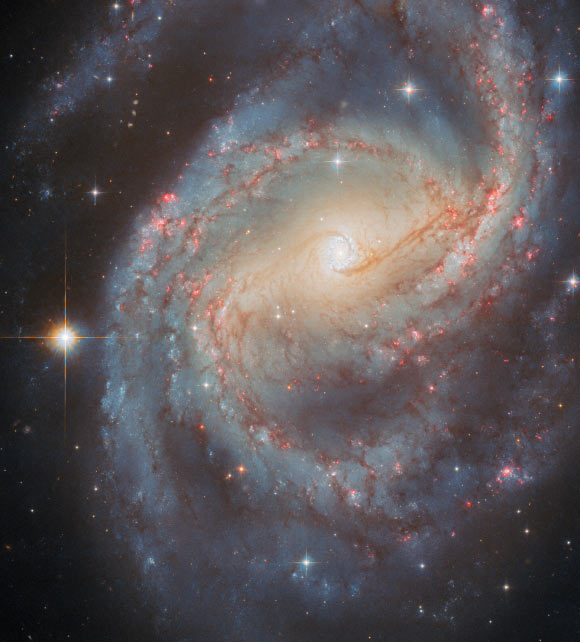NASA has released a beautiful close-up shot of NGC 6951, a barred spiral galaxy captured by the NASA/ESA Hubble Space Telescope.

This Hubble image shows NGC 6951, a barred spiral galaxy some 70 million light-years away in the constellation of Cepheus. The color image was made from separate exposures taken in the visible and near-infrared regions of the spectrum with Hubble’s Advanced Camera for Surveys (ACS). Two filters were used to sample various wavelengths. The color results from assigning different hues to each monochromatic image associated with an individual filter. Image credit: NASA / ESA / Hubble / L.C. Ho / G. Brammer / A. Filippenko / C. Kilpatrick.
NGC 6951 is located around 70 million light-years away from Earth in the constellation of Cepheus.
Also catalogued as NGC 6952, LEDA 65086, IRAS 20366+6555, and UGC 11604, the galaxy is about 75,000 light-years across.
NGC 6951 was discovered independently by the French astronomer Jerome Coggia in 1877 and the American astronomer Lewis Swift in 1878.
Astronomers classify it as a barred spiral galaxy, a Type II Seyfert galaxy, and a low-ionization nuclear emission-line region (LINER) galaxy.
“As this Hubble image shows, NGC 6951 is a spiral galaxy with plenty of intriguing structures,” the Hubble astronomers said in a statement.
“Most eye-catching are its spiral arms, which are dotted with brilliant red nebulae, bright blue stars and filamentary dust clouds.”
“The spiral arms loop around the galactic center, which has a golden glow that comes from a population of older stars.”
“The center of the galaxy is also distinctly elongated, revealing the presence of a slowly rotating bar of stars.”
At the center of NGC 6951 lies a supermassive black hole surrounded by a so-called circumnuclear ring.
“NGC 6951’s bar may be responsible for another remarkable feature: a white-blue ring that encloses the very heart of the galaxy,” the astronomers said.
“This is called a circumnuclear starburst ring — essentially, a circle of enhanced star formation around the nucleus of a galaxy.”
“The bar funnels gas toward the center of the galaxy, where it collects in a ring about 3,800 light-years across.”
“Two dark dust lanes that run parallel to the bar mark the points where gas from the bar enters the ring.”
“The dense gas of a circumnuclear starburst ring is the perfect environment to churn out an impressive number of stars.”
Using the Hubble data, astronomers identified more than 80 potential star clusters within NGC 6951’s ring.
“Many of the stars formed less than 100 million years ago, but the ring itself is longer-lived, potentially having existed for 1-1.5 billion years,” the researchers explained.







